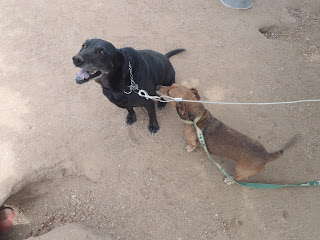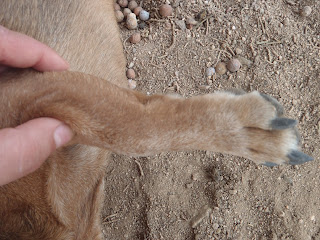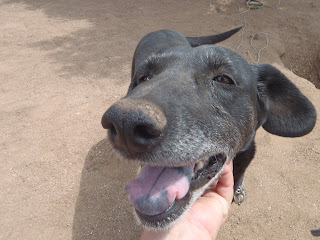 |
The gymnosperms are a group of seed-producing plants. "Gymnosperm" means naked seed. Gymnosperms were the dominant land plants in the age of dinosaurs.
|
 |
| A roly poly is an animal that has a segmented body. The "pill bug" is a small, segmented land creature that can roll into a tiny ball for protection. The pill bug is not an insect, it is an isopod. |

Cohesion is the property of like molecules to stick to each other due to mutual attraction. Adhesion is the property of different molecules or surfaces to cling to each other.
 The side of the dog is where the digestive system is located. Dogs do not have a ruminant system in side of their digestive system, however I used my dog as an example of where the ruminant would be located on an animals that does carry the ruminant. A ruminant is a mammal that digests plant-based food by initially softening it within the animal's first compartment of the stomach. (Wikipedia)
The side of the dog is where the digestive system is located. Dogs do not have a ruminant system in side of their digestive system, however I used my dog as an example of where the ruminant would be located on an animals that does carry the ruminant. A ruminant is a mammal that digests plant-based food by initially softening it within the animal's first compartment of the stomach. (Wikipedia)
Mycorrhizae, also known as fungus, is between the roots of a vascular plant. Mycorrhizae is usually the color green. On my tree it looks exactly like the leafs that belong to the tree, but if you looked closely at my tree you would be able to tell the difference between the actual leaves and the fungus. When you see the mycorrhizae you are actually supposed to pull them off of the tree, because this is not healthy for the tree. It will eventually take over.

 Every animal adapts to the type of environment they live in. When they adapt to their environment the animal develops territorial behavior. Territorial Behavior is different for every type of animal. It could be how they behave, what the animal does in certain situations, or as the picture above shows, where the animal does it's business. My dog is always in our backyard, so she adapted to having a wild life. Her territorial behavior would be shown by her "poop." However, she knows to only do it in one place.
Every animal adapts to the type of environment they live in. When they adapt to their environment the animal develops territorial behavior. Territorial Behavior is different for every type of animal. It could be how they behave, what the animal does in certain situations, or as the picture above shows, where the animal does it's business. My dog is always in our backyard, so she adapted to having a wild life. Her territorial behavior would be shown by her "poop." However, she knows to only do it in one place.
Radial symmetry in animals is a line going down the front of their body. I used a ruler to show the radial symmetry of my dog. This symmetry starts from the front of the animals head and goes straight down. 

 Tropism is the turning or bending movement of an organism that moves towards or away from an external stimulus, such as light, heat, or gravity (dictionary.com). This stem from the rose plant is bent towards the light from the sun. The sun, along with water, will help the rose plant produce roses.
Tropism is the turning or bending movement of an organism that moves towards or away from an external stimulus, such as light, heat, or gravity (dictionary.com). This stem from the rose plant is bent towards the light from the sun. The sun, along with water, will help the rose plant produce roses.
These roots have grown over time into the ground. This is known as succession. Succession is a gradual process by which ecosystems change and develop over time (dictionary.com). There are two types of succession, primary and secondary succession. This picture is a secondary succession because this happened after a tree was cut down in my community.

 Worms are detritovores. Detritovores are consumers and they feed on dead plants or animal matter.
Worms are detritovores. Detritovores are consumers and they feed on dead plants or animal matter.
The cuticle layer of a plant covers the epidermis of the green part of the plant. The cuticle layer protects the plant against "UV radiation and physical and chemical biological agents" (www.uni-muenster.de).

 The inside of the banana is called the endosperm. The inside of coconuts or corn is also called the endosperm.
The inside of the banana is called the endosperm. The inside of coconuts or corn is also called the endosperm.
Dogs are endothermic animals or "warm blooded" mammals. Their body heat is controlled by their metabolic rate just like humans and other mammals. Dogs start panting when they are hot so their body can cool down (earthlife.net)

 Gibberellins are found mostly in seedless grapes. Gibberellins occur in suitable environmental conditions.
Gibberellins are found mostly in seedless grapes. Gibberellins occur in suitable environmental conditions.
Cambium is on the inside of the stem of the tree. Cambium produces new phloem on the outside of the tree and new xylem on the inside of the stems and roots of the tree. This forms the rings of the tree.

Commensalism is where two organisms benefit from each other. So if there is a squirrel, the squirrel will benefit from this tree because it would be as a home for the squirrel. The tree would also benefit from the squirrel because sometimes squirrels forget their nuts inside the tree and if the nuts fall out of the tree, a new tree would end up growing because of the seeds of the nuts. So both organisms benefit from each other.

 ATP is adenosine triphosphate. ATP is produced by most living things in their cell's organelles called mitochondria. ATP stores the energy that we need as humans and that plants need to survive.
ATP is adenosine triphosphate. ATP is produced by most living things in their cell's organelles called mitochondria. ATP stores the energy that we need as humans and that plants need to survive.
Bilateral symmetry is something that is divisible into symmetrical halves. Bilateral symmetry, as shown with the ruler along my dog is cut along a central axis, so that the body is divided into equivalent right and left halves.

 The Calvin cycle is found in the stroma of the chloroplast, which enters the plant as CO2 and exits in the form of sugar.
The Calvin cycle is found in the stroma of the chloroplast, which enters the plant as CO2 and exits in the form of sugar. These two pictures are homologous structures. There is a difference between a dog arm and a human arm. They have different structures and different jobs.
 Adaptive radiation is the processes where organisms spread into new forms. The tree behind this tree spread and formed a new type of plant. The plant spread into different places throughout my backyard.
Adaptive radiation is the processes where organisms spread into new forms. The tree behind this tree spread and formed a new type of plant. The plant spread into different places throughout my backyard.
Analogous structures look similar, or perform similar functions, but they did not come from the same ancestral source.

 This is Altruistic behavior. Atruistic behavior is the adaptation of the behavior for the concern of others.
This is Altruistic behavior. Atruistic behavior is the adaptation of the behavior for the concern of others.  The auxin production area of a plant is a new "shoot" on a plant. If you look at where I am pointing at the picture you can see a new flower bud. This is where the auxin is produced.
The auxin production area of a plant is a new "shoot" on a plant. If you look at where I am pointing at the picture you can see a new flower bud. This is where the auxin is produced.
Basidiomycete is a type of fungus which produces "their basidia and basidiospores on or in a basidiocarp" (www.botany.hawaii.edu). Basidium is variable. 

A unicellular organism is also known as a single celled organism. This potato would be considered a unicellular organism. however, a potato plant would be considered as a multicellular organism because it has more than one potato.

 Xylem is one of the two transport tissues in vascular plants. Xylem is the primary water conducting tissue. The inside of this green onion is the xylem. A better example would be the inside of a celery stick, unfortunately I do not have any.
Xylem is one of the two transport tissues in vascular plants. Xylem is the primary water conducting tissue. The inside of this green onion is the xylem. A better example would be the inside of a celery stick, unfortunately I do not have any.
A rhizome is the modified root or stem of a plant. It is usually found underground so you would have to pull it out to see it. Some plants have the rhizome sticking out of the ground. Rhizomes develop from axillary buds. The rhizome is also used as a storage for starches. Sometimes if the rhizome is separated into pieces it will allow new plants to grow.

 A spore is usually adapted for survival. Spores are usually haploid and unicellular organisms. The spore of this plant is the outside. On the inside is the sporophyte.
A spore is usually adapted for survival. Spores are usually haploid and unicellular organisms. The spore of this plant is the outside. On the inside is the sporophyte.
The stigma is the tip of the carpel of a flower. The stigma will get pollen and adapts to catch and trap pollen. 

 Turgor pressure pushes the plasma membrane against the cell wall of the plant. So as you can see once I touched the part of the plant it started to bend away, that is the turgor pressure part.
Turgor pressure pushes the plasma membrane against the cell wall of the plant. So as you can see once I touched the part of the plant it started to bend away, that is the turgor pressure part.
A frond is a divided leaf on a plant, which are mostly the leaves of a fern.
 Fruits will produce ethylene as they begin to ripen. Although not shown in this peach because it still has not ripped, eventually it will do so. Ethylene is a small hydrocarbon gas that is a natural occurrence.
Fruits will produce ethylene as they begin to ripen. Although not shown in this peach because it still has not ripped, eventually it will do so. Ethylene is a small hydrocarbon gas that is a natural occurrence.
 The epithelial tissue is the top layer of all the tissues. It is the tissue that covers the surface of the body. It is specialized to form a covering of all internal and external body surfaces.
The epithelial tissue is the top layer of all the tissues. It is the tissue that covers the surface of the body. It is specialized to form a covering of all internal and external body surfaces.
 Long-day plants need light periods that are longer than a certain time. The picture of this cabbage is considered a long-day plant. Spinach, radish, and lettuce are other examples of long-day plants.
Long-day plants need light periods that are longer than a certain time. The picture of this cabbage is considered a long-day plant. Spinach, radish, and lettuce are other examples of long-day plants.
 Apples are low in their glycogen because of their fructose content. Apples provide longer lasting energy throughout the day.
Apples are low in their glycogen because of their fructose content. Apples provide longer lasting energy throughout the day.
 Phloem is found in vascular plants. Although not shown in this picture, but phloem is found all over this part of the tree. The phloem is the living tissue that carries organic nutrients to all parts of the tree where it is needed.
Phloem is found in vascular plants. Although not shown in this picture, but phloem is found all over this part of the tree. The phloem is the living tissue that carries organic nutrients to all parts of the tree where it is needed.
 Fruits will produce ethylene as they begin to ripen. Although not shown in this peach because it still has not ripped, eventually it will do so. Ethylene is a small hydrocarbon gas that is a natural occurrence.
Fruits will produce ethylene as they begin to ripen. Although not shown in this peach because it still has not ripped, eventually it will do so. Ethylene is a small hydrocarbon gas that is a natural occurrence.
Lipid is energy storage and fat. Fat can be found on the body often located on the stomach, as shown in the picture below of my brother's stomach. If a human had to go several days without eating, the body would end up resorting to eat away at the fat from the stomach. 

 The epithelial tissue is the top layer of all the tissues. It is the tissue that covers the surface of the body. It is specialized to form a covering of all internal and external body surfaces.
The epithelial tissue is the top layer of all the tissues. It is the tissue that covers the surface of the body. It is specialized to form a covering of all internal and external body surfaces.
An ectothermic animal is one who cannot regulate its own body temperature, so its body temperature fluctuates according to its surroundings. Shrimp is an example of an ectothermic animal. 

 Long-day plants need light periods that are longer than a certain time. The picture of this cabbage is considered a long-day plant. Spinach, radish, and lettuce are other examples of long-day plants.
Long-day plants need light periods that are longer than a certain time. The picture of this cabbage is considered a long-day plant. Spinach, radish, and lettuce are other examples of long-day plants.
Roots of plants come in a variety of sizes and shapes, adapted for several functions. Many are adapted for storage.The plants use up the stored sugars during fruit productions and flowering. Strawberries are a modified root of a plant. 

 Apples are low in their glycogen because of their fructose content. Apples provide longer lasting energy throughout the day.
Apples are low in their glycogen because of their fructose content. Apples provide longer lasting energy throughout the day.
The anther and filament of the stamen is where the pollen is produced. The anther is where the pollen is specifically held in the flower, and the filament is a small stem that holds up the anther. The anther can be attached to the filament either at the end or at the center. 

 Phloem is found in vascular plants. Although not shown in this picture, but phloem is found all over this part of the tree. The phloem is the living tissue that carries organic nutrients to all parts of the tree where it is needed.
Phloem is found in vascular plants. Although not shown in this picture, but phloem is found all over this part of the tree. The phloem is the living tissue that carries organic nutrients to all parts of the tree where it is needed.







No comments:
Post a Comment